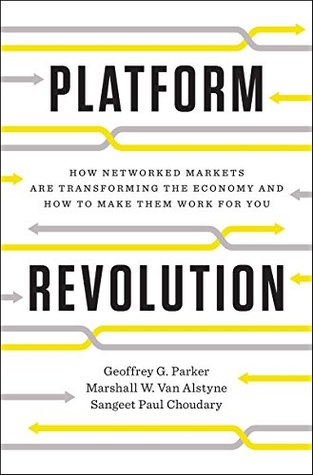More on this book
Community
Kindle Notes & Highlights
Read between
December 23, 2016 - June 6, 2017
The core interaction is the single most important form of activity that takes place on a platform—the exchange of value that attracts most users to the platform in the first place. The core interaction involves three key components: the participants, the value unit, and the filter.
fundamentally two participants in any core interaction: the producer, who creates value, and the consumer, who consumes value.
the same user may play a different role in differing interactions.
the core interaction starts with the creation of a value unit by the producer.
The value unit is delivered to selected consumers based on filters.
every platform makes use of filters to manage the exchange of information.
platforms don’t create value units; instead, they are created by the producers who participate in the platform.
platforms are “information factories” that have no control over inventory.
users won’t come to a platform unless it has value, and a platform won’t have value unless users use it.
keeping the interest of users who visit or sign up for the platform.
single-user feedback loop. This involves an algorithm built into the platform infrastructure that analyzes user activity, draws conclusions about the user’s interests, preferences, and needs, and recommends new value units and connections that the user is likely to find valuable.
multi-user feedback loop, activity from a producer is delivered to relevant consumers, whose activity in turn is fed back to the producer.
they create an infrastructure in which value can be created and exchanged, and lay out principles that govern these interactions.
matching the right users with one another and ensuring that the most relevant goods and services are exchanged.
a platform ecosystem can evolve faster when the core platform is a clean, simple system rather than a tangle of numerous features.
platforms cannot be entirely planned; they also emerge.
Chris Messina, an engineer at Google, originally suggested the use of hashtags to annotate and discover similar tweets. Today, the hashtag has become a mainstay of Twitter.
Internet no longer acts merely as a distribution channel (a pipeline). It also acts as a creation infrastructure and a coordination mechanism.
physical and the digital are rapidly converging,
superior marginal economics of production and distribution.
higher production leads to higher consumption, and vice versa.
While traditional intermediaries relied on manual efforts, platform intermediaries rely on algorithms and social feedback, both of which scale quickly and efficiently.
The re-intermediation produced by platforms is also changing the economics of participation for producers and consumers,
When multiple products and services connect and interact using data, pipelines can start behaving like platforms, producing new forms of value and encouraging users to engage in more interactions.
platforms must attract users by structuring incentives for participation—preferably incentives that are organically connected to the interactions made possible by the platform. Traditionally, the marketing function was divorced from the product. In network businesses, marketing needs to be baked into the platform.
users spread self-created value units to get social feedback, which in turn may bring them fun, fame, fulfillment, or fortune—or
A platform is “open” to the extent that (1) no restrictions are placed on participation in its development, commercialization, or use; or (2) any restrictions—for example, requirements to conform with technical standards or pay licensing fees—are reasonable and non-discriminatory, that is, they are applied uniformly to all potential platform participants.2
Information asymmetry arises whenever one party to an interaction knows facts that other parties don’t and uses that knowledge for personal advantage.
Externalities occur when spillover costs or benefits accrue to anyone not involved in a given interaction.
a well-designed market increases the safety of the market via transparency, quality, or insurance, thereby enabling good interactions to occur. It provides thickness, which enables participants from different sides of a multisided market to find one another more easily. It minimizes congestion, which hampers successful searches when too many people participate or low quality drives out high. And it minimizes repugnant activity—which explains why platform designers forbid porn on iTunes, human organ sales on Alibaba, and child labor on Upwork.
The underlying principle: Give fast, open feedback when applying laws that define good behavior, but give slow, opaque feedback when applying laws that punish bad behavior.
first big principle of smart self-governance for platforms is internal transparency.
platform managers should strive to give all their business divisions a clear view across the entire platform.
Steve Yegge’s attempt to summarize a mandate issued by Amazon’s Jeff Bezos, captures the spirit of this principle very effectively. Bezos insisted that all members of the Amazon team must learn to communicate with one another using “service interfaces”—data communication tools specifically designed to be clear, understandable, and useful to everyone in the organization as well as to outside users and partners.
platform metrics need to measure the rate of interaction success and the factors that contribute to it.
For a platform manager, process efficiencies and system enhancements may be quite important—but only insofar as they facilitate successful interactions among users.
Platforms seek exclusive access to essential assets. They do this, in part, by developing rules, practices, and protocols that discourage multihoming.
new models are causing economic, environmental, social, or cultural harm.
government rules are often used to block competition and thwart innovation rather than to protect consumers and benefit society.
the historical record doesn’t support the arguments of people who favor no regulation of business.
Regulation to prevent anti-competitive practices goes back at least as far as ancient Greece and Rome, where state authorities took swift action to mitigate grain market price fluctuations that occurred due to natural (weather) events as well as deliberate market manipulation by merchants and shipping agents.
firms are usually quick to react to changing technology and market conditions, but they generally do not act to maximize social welfare unless forced to do so by the power of public opinion or by regulatory constraints.


